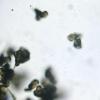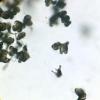
12-04-2016 15:55
 Florian Prell
Florian Prell
Hello togheter,a few weeks ago (05.03.2016) i foun

13-04-2016 00:08
Someone can get, the following literature:Martin,

12-04-2016 19:04
 Blasco Rafael
Blasco Rafael
Hola, esta miro por Hymenoscyphus pero no es segur

11-04-2016 23:18
 Dartanha Soares
Dartanha Soares
Hi to all,Found this one on decorticated wood (unk

12-04-2016 13:39
Thorben HülsewigHi there,i don't know if i'm right here, but i mak

11-04-2016 12:49
En ramas de poda, sin determinarAscomas muy peque�
Trimmatostroma scutellare?
Florian Prell,
12-04-2016 15:55
 Hello togheter,
Hello togheter,a few weeks ago (05.03.2016) i found an interesting fungus growing on a pine cone near Malschwitz, Germany. According to Ellis & Ellis this could be Trimmatostroma scutellare. Since Mycobank knows of 47 species in this genus i wanted to ask if there is any species that could fit to the collecting or if i could file this as Trimmatostroma scutellare?
Best regards,
Florian
Chris Yeates,
13-04-2016 00:08

Re : Trimmatostroma scutellare?
Hallo Florian
while I know Trimmatostroma betulinum well I have never collected T. scutellare. Here is the relevant page from Martin Ellis's More Dematiaceous Hyphomycetes (1976) it may be helpful as it has more information than the Ellis and Ellis volume.
best wishes
Chris
while I know Trimmatostroma betulinum well I have never collected T. scutellare. Here is the relevant page from Martin Ellis's More Dematiaceous Hyphomycetes (1976) it may be helpful as it has more information than the Ellis and Ellis volume.
best wishes
Chris
Florian Prell,
13-04-2016 10:37

Re : Trimmatostroma scutellare?
Hallo Chris,
thank you very much for the literature. I couldn't find anything that speaks against Trimmatostrome scutellare on this page also. So i guess i will file the collection under this name.
Best regards,
Florian
thank you very much for the literature. I couldn't find anything that speaks against Trimmatostrome scutellare on this page also. So i guess i will file the collection under this name.
Best regards,
Florian





 Triscu-1-0001.jpg
Triscu-1-0001.jpg